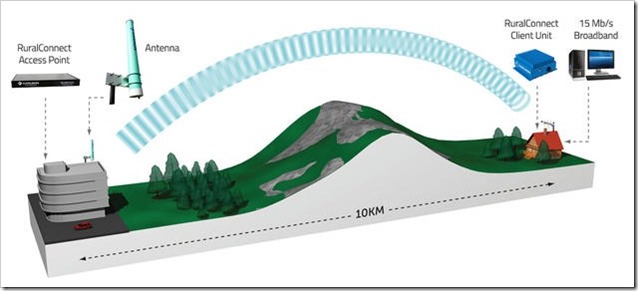Microsoft To Offer Free Internet In India Using ‘White Space’ Tech
Taking a cue from the Internet.org initiative by Facebook, Microsoft has come up with a brilliant plan to use the ‘white space’ technology and work towards providing free wireless internet connectivity to rural and remote areas of the country.
In the field of telecommunications, “White Space” refers to the unused spectrum between two TV channels. These unused frequencies are believed to hold the key for providing wireless broadband Internet access across the country. Devices which can be used in such white spaces are called “white space devices” (WSDs). Microsoft plans to use this white space technology to provide free last mile internet access to users in the most far-flung and hitherto inaccessible areas in India.
 Image: Carlson Wireless
Image: Carlson Wireless
The huge social networking giant (Facebook) and the most popular search engine (Google) are already working on their internet beaming drones and Project Loon (which involves placing balloon in high attitudes in the stratosphere) to provide internet access to remote areas across the country. Microsoft, not wanting to be left behind, will join them soon.
“Wi-fi has a range of only about 100 meters, whereas the 200-300 MHz spectrum band available in the white space can reach up to 10 km,” said Bhaskar Pramanik, chairman, Microsoft India. “This spectrum belongs mainly to Doordarshan and the government and is not used at all. We have sought clearance for a pilot project in two districts.”
“The challenge is the lack of digital infrastructure across India. This initiative addresses this challenge in a cost-effective manner and creates an eco-system that will benefit everyone, including manufacturers of routers and other technology devices, other technology companies, besides Microsoft,” Pramanik said.
Though this white space technology has been used in countries like Ghana, South Africa and UK earlier, it has not been commercially deployed at the scale being proposed for India. Experts are sure that it can lead to a huge spurt in internet connectivity in a country like ours.
At present, Microsoft is looking forward to prove that their proposed technology is commercially viable. For that, it will require a green signal from various Indian regulatory bodies for the use of spectrum. Considering that the project, if successful, could mean internet access at a speed of upto 4Mbps at a cost of only Rs 130 per user, it does sound like a great idea.
If the pilot projects in these two districts turn out to be successful, the project might be rolled out all over the country. This could be a huge shot in the arm for Prime Minister Narendra Modi’s Digital India campaign, Make in India initiatives and the Indian Prime Minister’s slogan of “IT+ IT= IT” (that is Indian Talent + Information Technology = India Tomorrow)
The new government which took over in May 2014 has shown keen interest towards the development of the IT sector. Under the leadership of the new Prime Minister, the government is working towards extending broadband access to 2.5 lakh panchayats across the country.
Providing internet connectivity to people not yet connected to www has now touched a new chord with the American tech giants. Realizing that the most rapidly expanding markets are the ones which have yet been deprived of internet access, they want to capture these lucrative markets by being among the first to provide the internet connectivity. They know these markets could mean huge business for them and, ultimately, huge profits – though they try to present these programs in the form of charity at the moment.

[…] Concept wise, Quarkson’s innovation appears similar to Titan Aerospace, which was acquired by Google last year. They develop solar powered satellites, which can help to transmit Internet and assist during disasters. This joins the rank of other such innovations in the field of Internet transmission such as usage of balloons by Google and white space by Microsoft. […]
[…] Android and iOS users ; free Windows OS Mobile for any device which is less than 9 inches; planning free Internet in India using white space technology; luring small scale businessmen with discounted Cloud computing; and […]